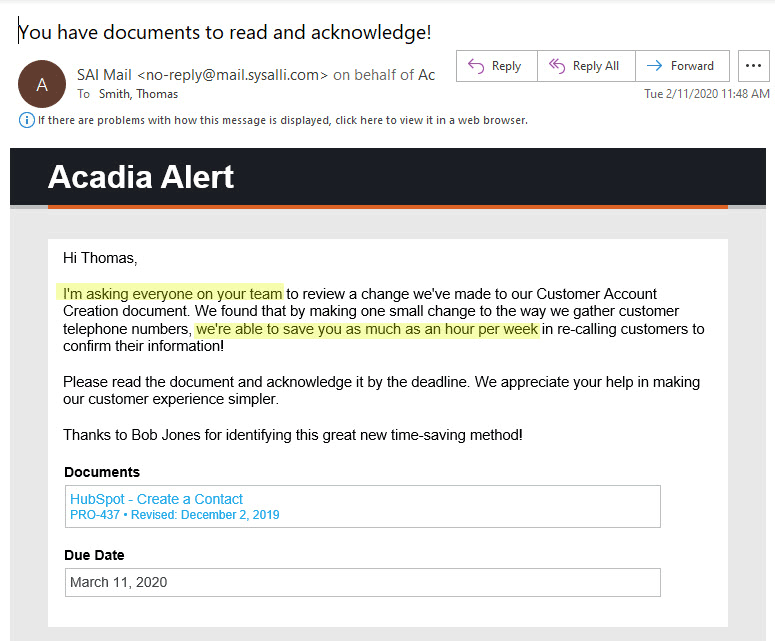3 Steps to Avoid Workplace Injuries, Fines, and Rework
Sometimes a simple reminder is all it takes for employees to change their behavior.
- Creating social norms for policies and procedures causes more behavior change than other incentives.
- When employees believe their employer cares for their well-being, they’re more productive.
- Combining social norms and observation promotes change.

You probably know who your best, most reliable team members are. Their work is fast and efficient. Both customers and colleagues see them as capable and consistent. You probably turn to them to help train new employees. They follow the rules, and you never worry about them doing something dangerous or illegal.
Unfortunately, not every employee is as reliable. There are those who cut corners or do things the “old way”. In many cases it’s not the employee’s fault. Poor training or process documentation can account for a lot of these behaviors. And sometimes it’s as easy as telling someone the One Best Way to do something to get them to change.
The longer you don’t act, however, the more likely you are to put your employees, your customers, and your business at risk. Employees who don’t follow company policies are more prone to accidents and are more likely to make mistakes that cause rework.
Below are three easy steps that you can take to start helping your team understand and follow your existing policies and procedures.

1) Identify your One Best Way as the norm
Behavioral psychologists have found that what motivates people isn’t what you’d think.1 Higher salaries, better titles, and flexible work schedules are typically seen as the major motivating factors for employees. But in reality, it’s social norms that are most effective in getting us to change all sorts of behaviors – from recycling, to exercising, to following a work procedure.
We are genetically programmed to both perceive behaviors that are acceptable to the group and are more inclined to follow them than striking our own path.
So, in many ways, simply making your policies clear to your employees will cause them to reflexively begin to follow them.
2) Show that you care, and you’re paying attention
One of the oldest and most examined studies of workforce productivity is the Hawthorne Effect.2,3,4,5 The study had two major takeaways. Employees who know they are being observed doing their work are more likely to perform their jobs efficiently. Similarly, employees who felt that the observation was a result of their employer showing concern for their well-being were more productive.
Whether they think about it this way or not, a vast majority of your policies and procedures are likely in place to help employees. Whether it’s keeping them safe from injury or helping them to adhere to regulatory requirements, we create policies to make it easier for employees to do their jobs the One Best Way.
Explain your policies and procedures to your team by describing how they will benefit6,7 – nobody wants to redo tasks or hurt themselves.
3) Combine social norms and observation to promote change
In Acadia, you can share any document with a single employee, a team, or your entire workforce. You can also require them to acknowledge that they’ve read it. Acadia records the date and time they read the document and indicates this to the employee after their acknowledgement.
How this works in practice:
In the email alert requesting that the employee review the policy, note that the requirement isn’t just for them. Describe how they’ll benefit from following the procedure and be clear about your expectation for reviewing the document.

When the employee clicks on the document for review, they see a prompt at the top of the document. It gives them a deadline for acknowledging the document, so it’s clear that this is an important request.

After reviewing the document, the employee checks a box and clicks a button acknowledging that they’ve read it.

Upon clicking the Acknowledge button, the page quickly reloads, and a verification is shown at the top of the page. This reinforces that a record has been captured, and the employee is now responsible for following the policy.

Behavior Change in Action
Here are some examples of Acadia customers who have effectively used Acknowledgements to create positive behavior change within their organizations.
- 350 customer care reps at a bank call center were repeatedly failing to open new accounts correctly. Their manager sent them acknowledgments for the procedures used to correctly open new accounts. Shortly after sending out these acknowledgements, the company saw a decrease in errors of this kind.
- Highly customized shipping requirements in a distribution warehouse were often executed, riddled with errors. Outbound shipping team members who were identified as the lowest performers were required to acknowledge their work instructions. Afterward, returns and re-work dropped, reducing waste dramatically.
- Employees at a healthcare facility were provided policies and procedures to help them conform to regulatory requirements. By tracking the acknowledgement of these documents, the organization created an audit trail that lowered their risk of fines from regulatory non-compliance.
Start today!
When getting started with behavior change programs, it’s easy to get hung up in the implementation process. Trying to get everything perfect before you start loses sight of the purpose of continuous improvement and organizational change. Whether you start small or start big, you will learn and improve just by starting.
If you already have a policy or procedure in Acadia, you can send out an acknowledgement in as little as five minutes. Contact your Client Success Manager, and they’ll be happy to walk you through the process today.
Sources:
- Three Myths of Behavior Change – What You Think You Know That You Don’t: Jeni Cross at TEDxCSU
- The Hawthorne Effect
- Motivation at work: a key issue in remuneration
- The Hawthorne Effect: A precursor to employee productivity
- Handling the Hawthorne effect: The challenges surrounding a participant observer
- 7 Things Leaders Do to Help People Change
- 6 Effective Ways to Change Your Employees’ Behavior
Ready to crush your goals?
"*" indicates required fields


